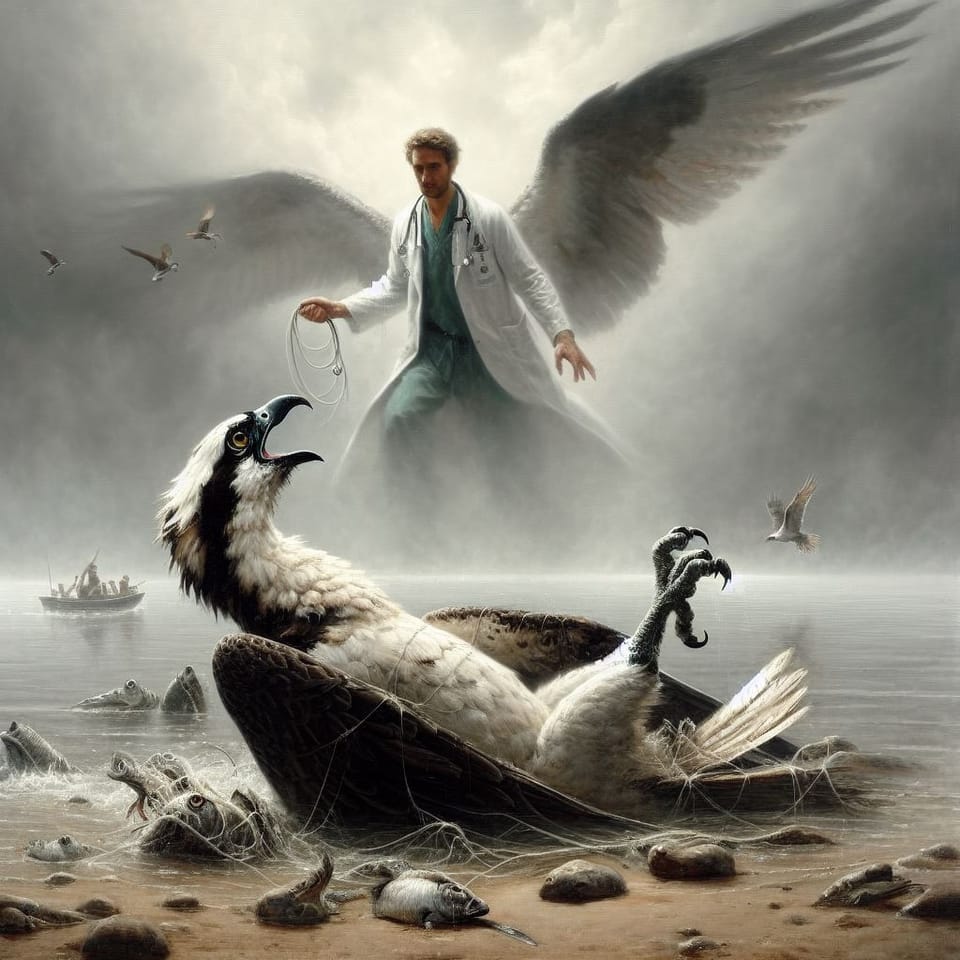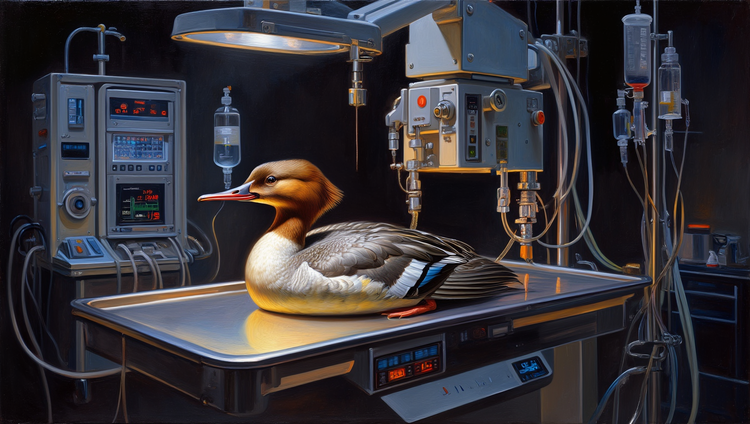The Osprey

I was swimming along the buoy line at a publicly accessible lake near my house. I needed to practice open water swimming, which is why I was in the lake. I didn't want to get run over by a jet ski, which is why I was swimming along the buoy line, and not across the lake. I don't know if this is the best way to practice open water swimming, but I hadn't put much serious thought into my gear, either.

So I swam back and forth along the buoy line in four feet of muck and algae, turning around every minute or so and trying not to feel like too much of a moron. It's water, it's open, I'm swimming in it. Why overcomplicate things?

In any case, my intense fear of being run over by a jet ski¹ meant I had a pretty paranoid eye on my proximity to the buoy line,. Which is how I noticed something strange from under water.

Subconsciously, I had already registered an abnormality. Before I was aware of it, I had stopped my strokes and gently exhaled as I came up to the surface. My instincts, for some reason, told me to stay calm. Something was off, but it wasn't a threat to me.

Several feet in front of me was an osprey. It was looking straight at me calmly. But I was much too close to this wild animal for it to be comfortable. I was inside it's flight distance.

Flight distance is the minimum distance at which an animal will tolerate your presence. Get too close to a herd of deer and they spook. Every animal has a unique flight distance. For black labs, the ideal distance between their tongue and your face is 0 inches. For Sasquatch, it's infinity times googleplex. When you work with animals, you get a sense for these things.
A built in flight distance is a pretty good way to avoid getting killed by dangerous things such as humans. The "eject" button gets automatically triggered within a certain radius of approach.
But here I was, well within this inviolable space, and the osprey just looked directly at me. It had the weak expression of an animal near death. It should have been acting like DEFCON 1², bu it sat there and looked at me. It was unsettling. The moment the water sheened off my goggles, I knew something was wrong. My presence inside the bubble was an infringement upon nature, and there must be some explanation.
Quickly, the explanation explained itself. As soon as I heard someone from the small crowd that was gathering mention that the bird's right wing was wrapped in some fishing line, I had it! Of course! It was entangled, it couldn't fly, and was succumbing to exhaustion in the cold lake water.
But this bird was in luck. It had hopped off the buoy line and was flapping its way to shore, half-submerged in the water. I could feel the sympathies of all four people gathered on the shore as they watched the poor animal struggle to move me out of it's flight distance. I leapt out of the water and scrambled after it, signalling to the crowd just how helpful I was about to become.

No time to explain the intricacies of wildlife medicine. No time to parse the statistics on bird of prey rehabilitation and rerelease. No time to find the person(s) responsible for the lost line and give them a gentle, scolding lecture on the broader implications of harm caused by discarded fishing gear to wildlife (50-80% of some whale species show signs of fishing gear related injuries).
Action was needed. So...
How the hell was I going to help?! What, realistically, would I be able to do in my swim trunks with a large bird of prey? Veterinarians, with rare and notable exceptions, don't treat their patients in the wild. We prefer places where we can control the situation. Especially when the patient has large talons, it's ideal to utilize some physical or chemical approach that maximizes safety. We try our best, but it's hard to convince any animal that a rectal exam is going to benefit them.

Not that I was planning a full physical exam. Not that I had any plan. I just knew that I was probably the most qualified person to help. Why not be helpful? State restrictions on the legality of a veterinarian-client-patient-relationship be dammed, humans fishing line had gotten the bird into this mess, and I'd be the representative from our kind who would put things right!
But how was I going to do it?
Years of experience had taught me that the best thing to do with a fearful, dangerous animal that wants nothing to do with humans is to throw an improvised lasso around it's neck and then drag it toward you. That way, you can both get a better assessment of what's going on and put your body at risk of serious injury.

And the osprey had been kind enough to tie a leash around it's wing already! This extraordinary plan in place, I crouched low and approached the end of the fishing line slowly. I'd pull the bird toward me, wrangle it into a restraint hold somehow, then somehow put into some sort of hopefully nearby container, then figure out how to transport it to a hopefully open and receiving wildlife rehabilitation center, then maybe get back to my swim.

None of these details had been worked out as I pulled the line toward me. The bedraggled osprey made no move to escape. The crowd held its breath. Slowly, delicately, with the soft dexterity of a surgeon, I took in the line. The slack tightened, but the bird's stance didn't change as the the long flight feathers of the right wing pulled toward me. A loop of line slipped off. I pulled a bit more, exhaling slowly as I collected the line in my hand.
Miraculously, the entire line dropped off!

This was good! But was it? Actually, now I thought I was screwed. This bird was too sick to make it. I'd have to scramble over the sand and grab it in a mad dash in order to help it. The fishing line, my one relatively safe approach to a "caution" patient had just been lost. Around this time I started wondering which zoonotic parasites ospreys might harbor. I mentally prepared my lecture to the crowd about how nature isn't always so kind. Hmmm...
The bird was fragile. I would need to be careful not to hurt it. But simultaneously, I didn't want my face ripped off. Even a sickie is dangerous. I needed to protect my vital (and likeable) organs until I could get a good hold on it. Thank goodness I watched a lot of Crocodile Hunter as a kid. I just hoped I was about to impress the crowd.
I crouched low, shimmied my shoulders loose, and lasered in on the dripping bird of prey several feet away from me. It stared straight at me over its limp right wing.
Here we go.
Then, a miracle happened.
Straining to lifting its tail, it plopped a large white turd on the beach in my direction. Freed from this (quite significant) load, it leapt into the air. The wings fully extended, catching that first precious inch of lift. We gasped in unison. The osprey hoisted itself magically. It gained momentum as it flapped and glided back out over the lake. It was only noon, but we all watched the reinvigorated animal soar into a marvelous sunset, rippling crimson beams of light with the fine silhouette of its wingtips.
My healing touch had restored balance to nature.

Well, maybe not exactly.
Postscript
But it's a true story, I swear. Actually, I have corroboration. A friend of mine was out doing some electrical work at the municipal buildings of the public lake a mere week later. While making small talk with the park staff, he got wind of the extraordinary tale of the veterinarian who had surfaced out of the lake like Excalibur and rescued an osprey in distress.
So look, my version isn't even the most exaggerated.
- Yes, it did almost happen once on the American River. I have since learned a great deal about water safety.
- I had always thought DEFCON 5 was the worst one. But not so. Boy I would have bungled the controls during a nuclear war.





Comments ()